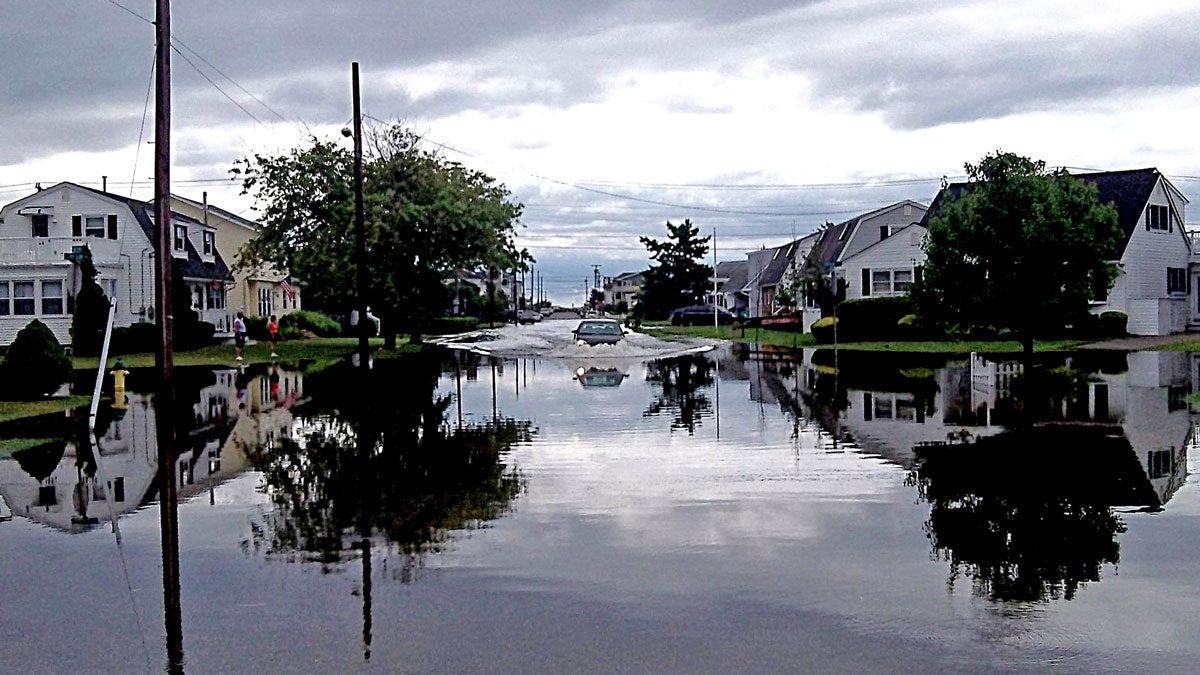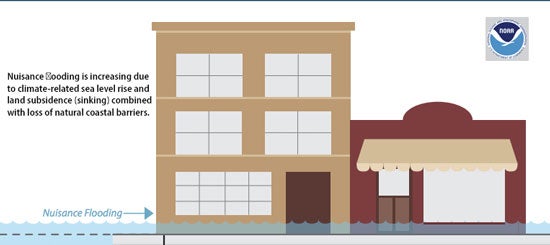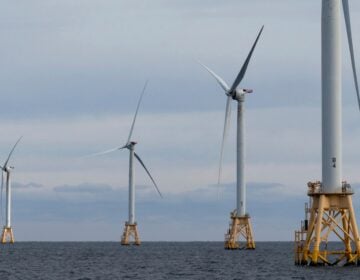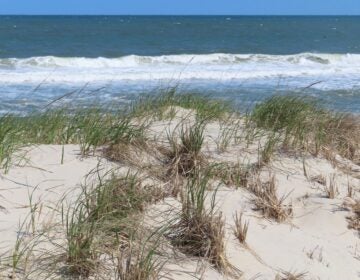NOAA: New Jersey will see an increase in nuisance flooding in 2017

Nuisance flooding is a part of life in New Jersey's coastal communities. (Bill Barlow for WHYY)
For Jersey Shore residents and regular summer visitors, it’s just part of life. Once in a while, even on a still and sunny day, tides get high enough that water seeps from the bays and inlets onto streets and intersections. Sometimes it washes across the marsh, sometimes it bubbles up from storm drains, and keeping it out is a big issue for infrastructure planning at the shore.
Typically, just a few puddles show up here and there, but sometimes, the water gets deep enough to require detours, or even close bridges. And according to projections from the National Oceanic and Atmospheric Administration, it will get worse.
A report released this month says shore dwellers and others should expect more of what NOAA describes as nuisance flooding in 2017, in part because of the possibility of the weather pattern known as El Nino developing this year. The report estimates Atlantic City could see more than 33 days of flooding in 2017, more than a month’s worth of flood days for the year. The report projects similar numbers for Lewes, Del., while Baltimore could see 18 days of flooding, if El Nino materializes this year. The report also projects an impact in Philadelphia, well away from the coast but still potentially subject to rising water.
While the most severe flooding typically occurs during hurricanes or other major storms, the kind of flooding detailed in this report can occur on sunny day, if the phase of the moon is right, or prevailing winds or a weather system far off shore pushes enough water toward the coastline.
“As relative sea level increases, it no longer takes a strong storm or a hurricane to cause coastal flooding. Flooding now occurs with high tides in many locations due to climate-related sea level rise, land subsidence, and the loss of natural barriers,” reads a statement from the NOAA website. “Nuisance flooding—which causes such public inconveniences as frequent road closures, overwhelmed storm drains and compromised infrastructure—has increased on all three U.S. coasts, between 300 and 925 percent since the 1960s.”

According to NOAA oceanographer William Sweet, the trend has been underway for many years, and will likely get worse.
“It is a fact that ocean levels are rising,” said Sweet, the lead author of the report who was described by NOAA officials as their sea level guy. And while the effect will hit coastal communities throughout the country, and the world, his models indicate things will be about 25 percent worse for the Jersey Shore compared to other areas in the nation. That’s because in addition to the oceans rising, New Jersey is sinking.
It also relates to where all this water will likely end up. As Sweet put it in a prepared statement, the oceans are not rising like water in a bathtub. The intensity of the impact will vary from one area to another.
Across the country, the oceans are rising by about three millimeters a year, which comes out to about an inch more sea level every 8 years. When other factors are taken into account, the number is closer to 4 millimeters a year in Atlantic City, or an inch every 6 years. That may not sound like much, but in relatively flat coastal communities, the water at high tide is never all that far away. “You’re at the beach. That’s where people want to be,” Sweet said.
Sweet has no issue with pointing the finger at global climate change, at least in part. Very detailed data have been compiled from all over the world, he said, and the results are clear: the oceans are warmer, and that trend correlates with the amount of carbon dioxide in the air. While many scientists say the question of carbon dioxide emission’s effect on worldwide temperature has been settled, some powerful skeptics remain, including President Trump. He has called climate change a hoax, although more recently his exact views have been hard to pin down. He pulled the United States out of the Paris Accords, an international agreement aimed at limiting global carbon emissions to reduce the impact of climate change,
Although he works for the federal government, and therefore for Trump, Sweet says the results are unequivocal: higher temperatures mean sea levels rise, which in turn means more damage to coastal communities.
“This is openly available information,” he said. People can look at the data for themselves and see what he’s talking about, he said. In a follow-up email, he said the question of whether humans are causing the current rate of sea level rise is “not as well resolved,” but he cited another study that indicated sea level rise would be less than half the current level without the global warming of the 20th century.
There are a few factors contributing to the rise, he said. The additional water in the oceans running off from melting glaciers and ice caps is a major contributor, he said, getting about two-thirds of the blame. But the water temperature itself has an impact. About a third of the rise can be attributed to something called thermal expansion, meaning the expansion of the now-warmer water in the oceans. Water expands when it heats up and contracts as it cools.
But that’s still not the whole picture.
As mentioned, the Mid-Atlantic states are gradually sinking, he said, as an ongoing result of the last ice age. At that point, catastrophic climate change drastically reduced global temperatures, with no help from human beings. Massive ice sheets covered the continent, and that weight actually moved the molten material from under the continental shelf. Over thousands of years, that material is seeping back where it came from, which means the portion of shelf that holds up the Jersey Shore is slowly sinking, as Sweet explained it. A more immediate change also contributes to that sinking: the depletion of groundwater under the state, brought to the surface from deep aquifers for irrigation, drinking water and other uses.
While the latest report focuses on minor flooding, an earlier report focused on the more catastrophic flooding that accompanies severe storms.
“Long-term sea level rise driven by global climate change presents a clear and highly consequential risks to the United States over the coming decades and centuries,” that reports reads. It states more people are moving to coastal communities each year, and that sea level increases will put these communities at risk.
Again, the report has bad news for the Mid-Atlantic coast: The warming water will slow the Gulf Stream, the massive river of warm water that flows north from the equator off the East Coast. That will also mean more water in this area of the ocean, according to Sweet, the lead author on that report as well. In an interview from the NOAA headquarters in Silver Springs, Md., he said he laid out three potential scenarios, assuming different levels of sea level rise, and the impact these scenarios could have over the coming decades. Each scenario sees more flooding, and more severe flooding. It comes down to a matter of degrees.
The worst-case scenario has ocean levels rising well over six feet by 2100, although that is not seen as the most probable result. In the best-case scenario, in 30 or 40 years, severe flooding each year becomes the norm in coastal communities, Sweet said.
“That’s the wake-up call. Things are changing, and they’re going to get worse in the future,” he said.The report states that the mean sea level around the world has increased 8 to 9 inches since 1880, including about 3 inches of that since 1993.
“Scientists expect that (global mean sea level) will continue to rise throughout the 21st century and beyond, because of global warming that has already occurred and warming that is yet to occur due to the still uncertain level of future emissions,” reads the report.
That does not mean abandoning the coasts, Sweet said. But he believes these projections need to be understood by local residents and officials so that they can plan for what’s coming.
For towns on the Jersey shore, that could include big spending on infrastructure like bulkheads to keep the water out, and pumping stations to improve drainage, allowing water to be pumped off streets when the tide is high.
Most towns end up with a mixed bag of solutions. For instance, in Ocean City, NJ, bulkheads keep back the baywater in some areas of town, while in others the tidal marsh sits a little below street level, with no barrier between them. And even where there are bulkheads, for the most part their repair and maintenance falls to the homeowner. Like most shore towns, the city has installed valves to allow water to drain off the streets, while keeping bay water from backing up into the system during high tides.The city is in the process of spending millions on drainage improvements, including a multimillion-dollar pump station for the northend. And elsewhere, a Cape May County project aims to lift the main road in and out of Sea Isle City above the level of future floods. But such projects are expensive, time consuming, and at times see public opposition. Which leaves the question open, will coastal towns be ready if the water keeps rising?
WHYY is your source for fact-based, in-depth journalism and information. As a nonprofit organization, we rely on financial support from readers like you. Please give today.





